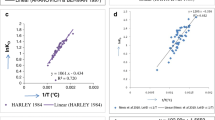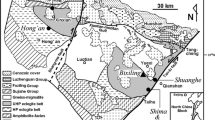Abstract
Applying Fe2+–Mg exchange geothermometers to natural samples may lead to incorrect temperature estimates if significant Fe3+ is present. In order to quantify this effect, high-pressure experiments were carried out in a belt apparatus in a natural system close to CFMAS at 5 GPa and 1,100–1,400 °C. The oxygen fugacity in the experiments was at or below the Re–ReO2 buffer. This is at significantly more oxidized conditions than in previous experiments, and, as consequence, higher Fe3+/Fe2+ ratios were generated. The Fe3+ content of garnet in the experiments was quantified by electron microprobe using the flank method. Making the usual assumption that Fetotal = Fe2+, the two-pyroxene thermometer of Brey and Köhler (J Pet 31:1353–1378, 1990) reproduced the experimental temperature to ±35 °C and the garnet–clinopyroxene Fe2+–Mg exchange thermometer of Krogh (Contrib Miner Pet 99:44–48, 1988) overestimated the temperatures on average by only 25 °C. On the other hand, application of the garnet–olivine (O’Neill and Wood in Contrib Miner Pet 70:59–70, 1979) and garnet–orthopyroxene (Harley in Contrib Miner Pet 86:359–373, 1984) exchange geothermometers yielded an underestimation in calculated temperatures of >200 °C. However, making explicit accounting for Fe3+ in garnet (i.e. using only measured Fe2+) leads to a vast improvement in the agreement between calculated and experimental temperatures, generally to within ±70 °C for the garnet–orthopyroxene geothermometer as well as noticeable improvement of calculated temperatures for the garnet–olivine geothermometer. Our results demonstrate that the two-pyroxene and garnet–clinopyroxene thermometers are rather insensitive to the presence of Fe3+ whilst direct accounting of Fe3+ in garnet is essential when applying the garnet–olivine and garnet–orthopyroxene thermometers.





Similar content being viewed by others
References
Berman RG, Koziol AM (1991) Ternary excess properties of grossular–pyrope–almandine garnet and their influence in geothermobarometry. Am Miner 76:1223–1231
Brey GP, Köhler T (1990) Geothermobarometry in four-phase lherzolites II. New thermobarometers, and practical assessment of existing thermobarometers. J Pet 31:1353–1378
Brey GP, Köhler T, Nickel KG (1990a) Geothermobarometry in four-phase lherzolites. I. Experimental results from 10 to 60 kb. J Pet 31:1313–1352
Brey GP, Weber R, Nickel KG (1990b) Calibration of a belt apparatus to 1800°C and 6 GPa. Geophys Res 95:15603–15610
Canil D (1999) The Ni-in-garnet geothermometer: calibration at natural abundances. Contrib Miner Pet 136:240–246
Canil D, O’Neill HSTC (1996) Distribution of ferric iron in some upper-mantle assemblages. J Pet 37:609–635
Creighton S, Stachel T, Matveev S, Höfer H, McCammon C, Luth RW (2009) Oxidation of the Kaapvaal lithospheric mantle driven by metasomatism. Contrib Miner Pet 157:491–504
Ellis DJ, Green DH (1979) An experimental study of the effect of Ca upon garnet–clinopyroxene Fe–Mg exchange equilibria. Contrib Miner Pet 71:13–22
Griffin WL, Cousens DR, Ryan CG, Sie SH, Suter GF (1998) Ni in chrome pyrope garnets: a new geothermometer. Contrib Miner Pet 103:199–202
Hamilton DL, Henderson CMB (1968) The preparation of silicate compositions by a gelling method. Miner Mag 36:832–838
Harley SL (1984) An experimental study of the partitioning of Fe and Mg between garnet and orthopyroxene. Contrib Miner Pet 86:359–373
Höfer HE, Brey GP (2007) The iron oxidation state of garnet by electron microprobe: its determination with the flank method combined with major element analysis. Am Miner 92:873–885
Höfer HE, Brey GP, Schulz-Dobrick B, Oberhänsli R (1994) The determination of the oxidation state of iron by the electron microprobe. Eur J Miner 6:407–418
Kawasaki T, Matsui Y (1977) Partitioning of Fe2+ and Mg2+ between olivine and garnet. EPSL 37:159–166
Krogh EJ (1988) The garnet–clinopyroxene Fe–Mg-geothermometer—a reinterpretation of existing experimental data. Contrib Miner Pet 99:44–48
Nimis P, Grütter H (2010) Internally consist geothermometers for garnet peridotites and pyroxenites. Contrib Miner Pet 159:411–427
O’Neill HSTC, Wood BJ (1979) An experimental study of Fe–Mg partitioning between garnet and olivine and its calibration as a geothermometer. Contrib Miner Pet 70:59–70
O’Neill HSTC (1980) An experimental study of Fe–Mg partitioning between garnet and olivine and its calibration as a geothermometer: corrections. Contrib Miner Pet 72:337
Pownceby MI, O’Neill HSTC (1994) Thermodynamic data from redox reactions at high temperatures. IV. Calibration of the Re–ReO2 oxygen buffer from EMF and NiO + Ni–Pd redox sensor measurements. Contrib Miner Pet 118:130–137
Purwin H, Lauterbach S, Brey GP, Woodland AB, Kleebe H-J (2013) An experimental study of the Fe oxidation states in garnet and clinopyroxene as a function of temperature in the system CaO–FeO–Fe2O3–MgO–Al2O3–SiO2: implications for garnet–clinopyroxene geothermometry. Contrib Miner Pet 165:623–639
Ryabchikov ID, Green DH, Wall VJ, Brey GP (1981) The oxidation state of carbon in the environment of the low velocity zone. Geokhimiya 2:221–232
Woodland AB (2012) Ferric iron budget of Kaapvaal cratonic mantle peridotite. Eur Geosci Union, abstract EGU2012-4669
Woodland AB, Koch M (2003) Variation in oxygen fugacity with depth in the upper mantle beneath the Kaapvaal Craton, southern Africa. EPSL 214:295–310
Acknowledgments
Fruitful discussions with V. Bulatov, K. Klimm, L.Uenver-Thiele and H. Purwin and help in the high-pressure laboratory are gratefully acknowledged.
Author information
Authors and Affiliations
Corresponding author
Additional information
Communicated by J. Hoefs.
Rights and permissions
About this article
Cite this article
Matjuschkin, V., Brey, G.P., Höfer, H.E. et al. The influence of Fe3+ on garnet–orthopyroxene and garnet–olivine geothermometers. Contrib Mineral Petrol 167, 972 (2014). https://doi.org/10.1007/s00410-014-0972-z
Received:
Accepted:
Published:
DOI: https://doi.org/10.1007/s00410-014-0972-z




